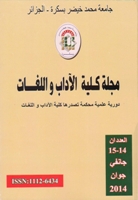Approaches to Teaching Writing
Résumé
أخذت تقنيات تدريس الكتابة في اللغة الانجليزية بالتطور بشكل ملحوظ خلال العقود الخمس الماضية فلطالما اعتبرت جزءا لا يتجزأ من قواعد اللغة ومنحت مركز مادة معينة والتي يمكن أن تدرس بشكل مستقل عن أي جانب آخر من جوانب اللغة هذا ما أكسبها مكانة مرموقة في المناهج التعليمية إضافة إلى الاهتمام المتزايد في دراسة مختلف مناهج وطرق التدريس المعقدة
يتميز عمل مدرس الكتابة اليوم بوجود مختلف أساليب التدريس والذي ينبغي عليه أن يختار منها وفقا لاحتياجات التلاميذ ومجموع الأهداف التي يسعى إلى تحقيقها في النهاية إنه هذا الاهتمام المتزايد في تعليم الكتابة الذي أدى إلى هذه المقالة مع هدف تعريف القارئ بالأساليب المحددة للكتابة
L’enseignement des techniques de l’écrit en langue anglaise a évolué de manière significative lors des cinq dernières décennies. Longtemps considéré comme étant partie intégrante de la grammaire, l’écrit s’est vu obtenir le statut de matière à part entière pouvant être enseignée indépendamment de tout autre aspect de la langue. Ceci lui a valu une place prépondérante dans le cursus d’enseignement de la langue et un intérêt grandissant dans le giron des approches et méthodes d’enseignement. Aujourd’hui, l’enseignant de l’expression écrite se retrouve devant un grand éventail de méthodes d’enseignement parmi lesquelles il doit choisir en fonction des besoins de ses apprenants et des objectifs à atteindre. C’est cet intérêt relativement nouveau pour l’enseignement de l’écrit qui a motivé la rédaction de cet article visant à familiariser le lecteur avec les approches d’enseignement de cet aspect de la langue.
Mots clés : Ecrit, enseignement, approches, méthode.
Références
Anderson, C. (1992). Free/style: a direct approach to writing. Boston: Houghton.
Byram, M. (2004).Genre and genre-based teaching.The RoutledgeEncyclopedia ofLanguage Teaching and Learning. London: Routledge.
Caudery, T. (2003). What the Process Approach Means .Retrieved April 2006 from engtc@huMAau.dk
Crookes, V., and C. Chaudron. (1991). Guidelines for classroom language teaching. In Teaching English as a second or foreign language, 2nd ed., ed. Celce-Murcia, M. Boston, MA: Heinle and Heinle Publishers.
Cheung, M. and Chan, A. (1994).Teaching Writing as a Process. Hong Kong:
Escholz, P. A. (1980). The prose model approach: using products in the process. In T. R. Donovan, and B. W McClelland. (eds.). Eight Approaches to Teaching Composition, Urbana 111 : National Council of Teachers of English.
Flower, L., & Hayes, J. R. (1981).Plans that guide the composing process In C.H.
Freedman, A. & Medway, P. (1994).Learning and teaching genre. Portsmouth, NH: Heinemann. In Aisian EFL Journal. 7, Issue two, Art 5.
Hicks, D. (1997).Working through discourse genres in school.Research in the Teaching of English, 31, 459-485.
Mahon, T. (1992). From sentence to story: A process approach to the development of composition skills in the primary school. In M. Lau and M. Murphy (Eds.) Developing writing: Purposes and Practices, Hong Kong: Institute of Language in Education.
Murray, D.M. (1992). Writing as process: How writing finds its own meaning. In T.R. Donovan and B.W. McClelland (eds), Eight approaches to teaching composition (pp. 3-20). Urbana, IL: National Council of Teachers of English.
Parson, G. (1985). Hand in hand: the writing process and the microcomputer. Juneau, AK: Alaska State Department of Education.
Pennington, M.C. and Cheung, M. (1993). Managing contextual factors in educational innovation: Process writing in Hong Kong. Journal of English and ForeignLanguage 2, 20-33.
Peyton, J. &Staton, J (1996).Writing Our Lives (2nd Edition). Washington, DC & McHenry, IL: CAL and Delta Systems, Inc
Pincas, A. (1984) Writing in English. London: Mac Millan
Poulton, S., (2004).Power writing. Retrieved March 2006, from http://www.thewritingsite.org/resources/approaches/power/default.asp
Raimes, A., (1983). Techniques in teaching writing. Honk Kong: Oxford American English.
Reid, J. (1984). The Radical Outliner and the Radical Brainstormer: A Perspective. Retrieved Feb. 2007, from www.sasked.gov.sk.ca/docs/xla/ela15c4.html
Spack, R. (1988). Initiating ESL students into the academic discourse community: How far should we go? TESOL Quarterly, 22, 29-51.
Swales, J. M. (1990).Genre analysis: English in academic and research settings. Cambridge: C.U.P.
White, R. V.(1988). Process and Product.In P. Robinson (Ed) Academic Writing. ELT Document, 129:4-16


